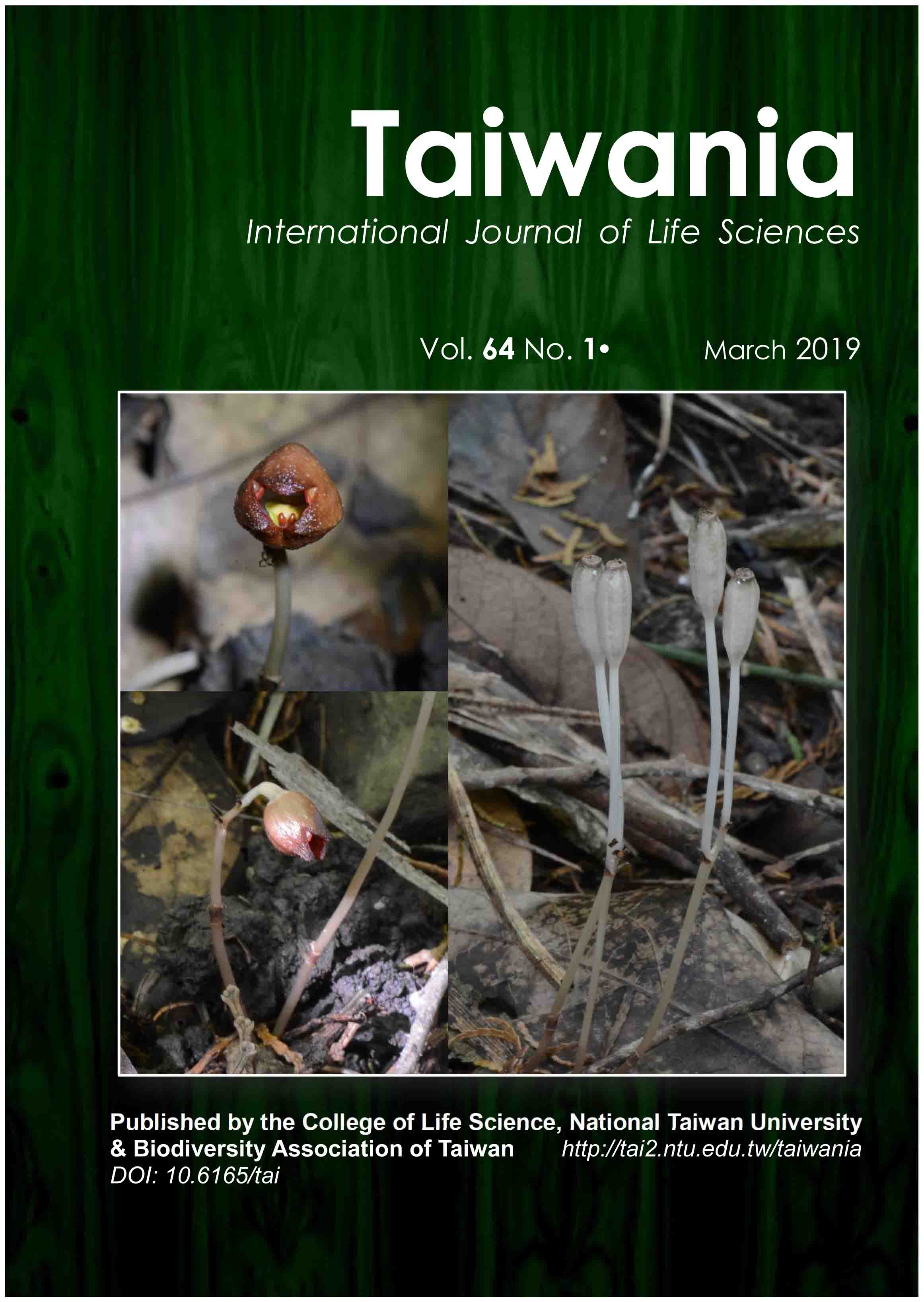Research Paper
Micromorphology and distribution of trichome in Saxifraga L. species from Western Indian Himalaya and its taxonomic implications
Dharmendra Singh Rawat, Priyanka Uniyal, Satish Chandra
Published on: 05 January 2019
Page: 13 - 22
DOI: 10.6165/tai.2019.64.13
Abstract
Trichomes are present in all species of Saxifraga L. barring few exceptions. In present study trichomes of 27 species, (among which 14 species not studied earlier), occurring in Indian Western Himalaya were examined and their distribution on plant parts was recorded. Eight types of trichomes were recognized. Among the all plant parts, trichomes are present on the pedicel of maximum species (26 species) worked out. Structural diversity and distribution of trichomes in different sections and subsections show a little systematic relevance. However, a species level differentiation is possible in this genus and an artificial key based on structure and distribution of trichomes is proposed for species identification.
Keyword: Artificial keys; Saxifraga; Species identification; Trichomes; Trichome distribution; Uttarakhand; Western Himalaya
Literature Cited
Agnihotri, P.and T. Husain. 2013. An overview of genus Saxifraga L. in Indian Himalayas. Ann. Pl. Sci. 2(8): 278-283.
Agrawal, A.A., J.K. Conner and J.R. Stinchcombe. 2004. Evolution of plant resistance and tolerance to frost damage. Ecol. Lett. 7(12): 1199-1208.
DOI: 10.1111/j.1461-0248.2004.00680.xView Article
Google Scholar
Akiyama, S. and R.J. Gornall. 2012. Saxifraga L. In: M.F. Watson et al. (eds.), Flora of Nepal. pp. 254-255, Royal Botanic Garden, Edinburgh.
Benz, B.W. and C.E. Martin. 2006. Foliar trichomes, boundary layers, and gas exchange in the species of epiphytic Tillandsia (Bromeliaceae). J. Plant Physiol. 163(6): 648-656.
DOI: 10.1016/j.jplph.2005.05.008View Article
Google Scholar
Callow, J.A. (ed.) 2000. Plant Trichomes. Academic Press, Elsevier. 311 pp.
Gornall, R.J. 1986. Trichome anatomy and taxonomy of Saxifraga (Saxifragaceae). Nord. J. Bot. 6(3): 257-275.
DOI: 10.1111/j.1756-1051.1986.tb00877.xView Article
Google Scholar
Gornall, R.J. 1987. An outline of a revised classification of Saxifraga L. Bot. J. Linn. Soc. 95(4): 273-292.
DOI: 10.1111/j.1095-8339.1987.tb01860.xView Article
Google Scholar
Grierson, A.J.C. 1987. Saxifragaceae. In: A.J.C. Grierson and D.G. Long (eds.), Flora of Bhutan, 1(3): 492-515. Royal Botanic Garden, Edinburgh.
Engler, H.G.A. and E. Irmscher. 1916-19. Saxifraga. In: A. Engler (ed.), Das Pflanzenreich, (IV, 117), 67, 69: 1-709, Wilhelm Engelmann, Leipzig.
Gao, Q.-B., Y.-H. Li, R.J. Gornall, Z.-X. Zhang, F.-Q. Zhang, R. Xing, P.-C. Fu, J.-L. Wang, H.-R. Liu, Z.-Z. Tian and L.-S. Chen. 2015. Phylogeny and speciation in Saxifraga sect. Ciliatae (Saxifragaceae): evidence from psbA-trnH, trnL-F and ITS sequences. Taxon 64(4): 703-713.
DOI: 10.12705/644.3View Article
Google Scholar
Jeffree, C.E. 1986. The cuticle, epicuticular waxes and trichomes of plants, with reference to their structure, function and evolution. In: B. Juniper and S.R. Southwood (eds.), Insects and the plant surface, pp. 23-64, Arnold, London.
Mabberley, D.J. 2017. Mabberley's plant-book: a portable dictionary of plants, their classifications, and uses. 4th ed., Cambridge University Press, Cambridge, UK. 1102 pp.
Mellon, J.E., C.A. Zelaya, M.K. Dowd, S.B. Beltz and M.A. Klich. 2012. Inhibitory effects of gossypol, gossypolone, and apogossypolone on a collection of economically important filamentous fungi. J. Agric. Food Chem. 60(10): 2740-2745.
DOI: 10.1021/jf2044394View Article
Google Scholar
Metcalfe, C.R. and L. Chalk. 1950. Anatomy of the Dicotyledons. Clarendon Press. Oxford. 806 pp.
Oelschlagel, B., S. Gorb, S. Wanke and C. Neinhuis. 2009. Structure and biomechanics of trapping flower trichomes and their role in the pollination biology of Aristolochia plants (Aristolochiaceae). New Phytol. 184(4): 988-1002.
DOI: 10.1111/j.1469-8137.2009.03013.xView Article
Google Scholar
Payne, W.W. 1978. A glossary of plant hair terminology. Brittonia 30(2): 239-255.
DOI: 10.2307/2806659View Article
Google Scholar
Peterson, R.L. and J. Vermeer. 1984. Histochemistry of trichome. In: E. Rodriguez and P.L. Healey (eds.), Biology and chemistry of plant trichome, pp. 71-94, Plenum Press, New York.
DOI: 10.1007/978-1-4899-5355-1_4View Article
Google Scholar
Simpson, M.G. 2010. Plant Systematics. Elsevier. 740 pp.
DOI: 10.1016/B978-0-12-374380-0.50001-4View Article
Google Scholar
Skaltsa, H., E. Verikokidou, C. Harvala, G. Krabourniotis and Y. Manetas. 1994. UV protective potential and flavonoid content of leaf hairs of Quercus ilex. Phytochemistry 37(4): 987-990.
DOI: 10.1016/S0031-9422(00)89514-XView Article
Google Scholar
The Plant List. 2013. Version 1.1. Published on the Internet; http://www.theplantlist.org/ (accessed December 20, 2017).
Tkach, N., M. Roser, G. Miehe, A.N. Muellner-Riehl, J. Ebersbach, A. Favre and M.H. Hoffmann. 2015. Molecular phylogenetics, morphology and a revised classification of the complex genus Saxifraga (Saxifragaceae). Taxon 64(6): 1159-1187.
DOI: 10.12705/646.4View Article
Google Scholar
Thiers, B. [continuously updated]. Index Herbariorum: A global directory of public herbaria and associated staff. New York Botanical Garden's Virtual Herbarium.http://sweetgum.nybg.org/science/ih/
Uniyal, P. 2016. Studies on the Genus Saxifraga L. (Saxifragaceae) in Western Himalaya, India. Unpublished M.Sc. thesis, G.B. Pant University of Agriculture & Technology, Pantnagar, India. 151 pp.
Wagner, G. J., E. Wang and R. W. Shepherd. 2004. New Approaches for Studying and Exploiting an Old Protuberance, the Plant Trichome. Ann. Bot. 93(1): 3-11.
DOI: 10.1093/aob/mch011View Article
Google Scholar
Web, D.A. and R.J. Gornall. 1989. Saxifrages of Europe. Christopher Helm, London, UK. 307pp.
Werker, E. 2000. Trichome diversity and development. Adv. Bot. Res. 31: 1-35.
DOI: 10.1016/S0065-2296(00)31005-9View Article
Google Scholar
Zhang, Z. 2013. Phylogenetic studies in the genus Saxifraga (Saxifragaceae). Ph.D. Thesis, University of Leicester, England. 310 pp.


